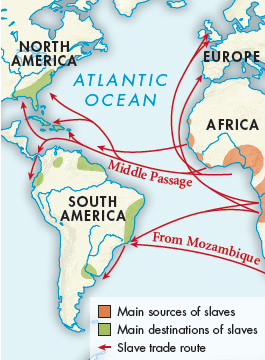Understanding World Societies:
Printed Page 475
Sugar and Early Transatlantic Slavery
Two crucial and interrelated elements of the Columbian exchange were the transatlantic trade in sugar and slaves. Throughout the Middle Ages, slavery was deeply entrenched in the Mediterranean, but it was not based on race. How, then, did black African slavery enter the European picture and take root in South and then North America? In 1453 the Ottoman capture of Constantinople halted the flow of European slaves from the eastern Mediterranean. Additionally, the successes of the Christian reconquest of the Iberian Peninsula drastically diminished the supply of Muslim captives. Cut off from its traditional sources of slaves, Mediterranean Europe turned to sub-
As Portuguese explorers began their voyages along the western coast of Africa, one of the first commodities they sought was slaves. While the first slaves were simply seized by small raiding parties, Portuguese merchants soon found that it was easier and more profitable to trade with African leaders, who were accustomed to dealing in enslaved people captured through warfare with neighboring powers. From 1490 to 1530 Portuguese traders brought between three hundred and two thousand enslaved Africans to Lisbon each year.
In this stage of European expansion, the history of slavery became intertwined with the history of sugar. Population increases and greater prosperity in the fifteenth century led to increasing demand for sugar. The establishment of sugar plantations on the Canary and Madeira Islands in the fifteenth century testifies to this demand.
Sugar was a particularly difficult crop to produce for profit, requiring constant, back-

The transatlantic slave trade that would ultimately result in the forced transport of over 12 million individuals began in 1518, when Spanish king Charles V authorized traders to bring enslaved Africans to New World colonies. The Portuguese brought the first slaves to Brazil around 1550. After its founding in 1621, the Dutch West India Company transported thousands of Africans to Brazil and the Caribbean, mostly to work on sugar plantations. In the late seventeenth century, with the chartering of the Royal African Company, the English began to bring slaves to Barbados and other English colonies in the Caribbean and mainland North America.
Before 1700, when slavers decided it was better business to improve conditions, some 20 percent of slaves died on the voyage from Africa to the Americas.2 The most common cause of death was dysentery induced by poor-